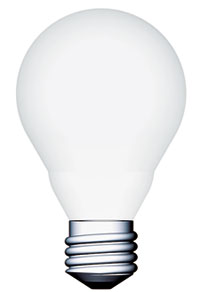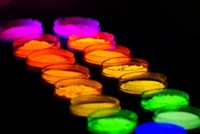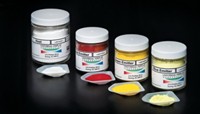Advertisement
Grab your lab coat. Let's get started
Welcome!
Welcome!
Create an account below to get 6 C&EN articles per month, receive newsletters and more - all free.
It seems this is your first time logging in online. Please enter the following information to continue.
As an ACS member you automatically get access to this site. All we need is few more details to create your reading experience.
Not you? Sign in with a different account.
Not you? Sign in with a different account.
ERROR 1
ERROR 1
ERROR 2
ERROR 2
ERROR 2
ERROR 2
ERROR 2
Password and Confirm password must match.
If you have an ACS member number, please enter it here so we can link this account to your membership. (optional)
ERROR 2
ACS values your privacy. By submitting your information, you are gaining access to C&EN and subscribing to our weekly newsletter. We use the information you provide to make your reading experience better, and we will never sell your data to third party members.
Energy
The End Of The Light Bulb
Global warming, ever-expanding energy demand pave way for new lighting technologies
by Jeff Johnson
December 3, 2007
| A version of this story appeared in
Volume 85, Issue 49

There's a revolution going on in lighting. And some say it's about time.
Two hundred years ago, British scientists forced electrons through a strip of platinum and laid the groundwork for what would become the first incandescent light. In 1870s and '80s, Thomas Edison and several competitors put the bulb on a path to commercialization and changed the world.
Today, for most people who have electric lights in their homes, illumination still comes from electricity run through a wire filament, enclosed and protected in a glass bulb.
Cheap, simple, easy to install, and manufactured by the billions, the incandescent light bulb is a staple of modern life. Unfortunately, 90 to 95% of the energy it consumes goes to heat, not light. Billions of bulbs wasting trillions of watt-hours of electricity is always bad, but particularly so in a time of increasing concern over climate change—when electrical power generation contributes more than one-third of the greenhouse gases that are changing Earth's environment.
Lighting is a big player in the global warming game. Illumination eats up about 19% of global power, and energy consumption for lighting is projected to grow by 60% over the next 25 years, according to the International Energy Agency (IEA).
In the U.S., about 22% of the total electricity demand is used for lighting. Of this 22%, half is used in lighting commercial businesses, 27% is for homes, 14% for industry, and 8% for outdoor applications, according to the Department of Energy. About $58 billion a year is spent on lighting.
Since homes remain highly dependent on inefficient incandescent lighting, residences are responsible for the greatest amount of wasted energy. They also have the biggest potential for savings, however, thanks to alternatives to traditional bulbs, which are growing in availability and impact. These bulbs could disrupt the definition of lighting.
Compact fluorescent lights (CFLs) draw only about 20 to 25% of the energy of incandescent bulbs for a comparable amount of light generated. Although they cost about four times more, CFLs last 10 times longer than incandescent bulbs and make back their price severalfold in energy savings and extended life.
Solid-state technologies are coming on too, with light-emitting diodes (LEDs) finding growing general lighting applications. LEDs are as efficient as CFLs and last for decades but are now too expensive to compete on all fronts with a light bulb. Organic light-emitting diodes (OLEDs) are waiting in the wings, providing a thin sheet of pure white light.
At their core, CFLs and LEDs are completely different technologies from that of incandescent bulbs. They do not rely on incandescence or intense heat to produce visible light. Instead, they produce visible light waves by using energy given off from the transition of electrons from one energy level to another.

Residential lighting consumes about 16% of electricity used in U.S. homes, says John Cymbalsky, operations research analyst with DOE Energy Information Administration. This works out to 6% of all U.S. electricity. Using CFLs or solid-state lighting would save about 4% of this total electricity, savings which would avoid building the equivalent of roughly 20 new 1,000-MW nuclear power plants.
But getting people to shift from the common light bulb is tough. It is hard to beat an incandescent light for low cost and ease in replacement—buy it for a half-a-buck, screw it in, flip the switch, and forget about it. Even so, Wal-Mart, Home Depot, and other big-box retailers; several utilities; and DOE have all embarked on programs to kill off the incandescent light.
Last year, Wal-Mart announced its intention to sell 100 million CFLs by the end of 2007. In October, it crowed that it had already met its goal.
Wal-Mart just didn't stick the lights on a shelf and hope, explains company spokeswoman Tara Raddohl. It marketed the CFLs under its own brand Great Value, sold them below competitors' prices, prominently displayed the new stock, set up interactive demonstrations to explain the lights' attributes, and promoted CFL sales as part of the company's new sustainable products program.
Wal-Mart even underscored its sales and sustainability programs by announcing its intention to pressure its manufacturer to reduce the small amount of mercury in CFLs. Mercury vapors in fluorescent lighting emit ultraviolet light when hit with a beam of electrons. The UV energy excites a phosphor on the inside surface of the glass tube, causing it to fluoresce and produce photons of visible light.
Late last year, California's Pacific Gas & Electric Corp. announced its plan to give away 1 million CFLs to customers in its Northern California service area. Energy savings and avoiding construction of new power plants played a "huge role" in justifying the giveaway program, says spokeswoman Katie Romans. "The program saves us more than 400,000 MWh of new capacity and enough electricity to power 60,000 homes for a year.
"California's electricity use has remained basically flat over the last 30 years, while the rest of the country's use has spiked," Romans says. "Our customers now expect these kinds of programs."

For the holidays, PG&E is offering free LED holiday light strings in exchange for old incandescent light strings, Romans adds. She estimates LED light strings will cut holiday energy consumption by 90%, compared with incandescents. They'll last for 20 holidays, and even with their higher price, LED strings pay for themselves in a season. PG&E is also working with the city of Oakland on a trial program to replace its 35,000 streetlights with LEDs, similar to efforts in other U.S. cities.
DOE has also begun its own program to encourage Americans to replace at least one incandescent bulb with a CFL, estimating that such a one-bulb swap would save enough electricity to light more than 3 million homes for a year.
Worldwide, the screw-base lighting market is about 12.5 billion lamps, Paul Waide, a senior policy analyst with IEA, told a Senate committee in September. Waide notes that almost all governments in nations making up the Organization for Economic Cooperation & Development are looking into a phaseout of incandescent lights, including the U.S., which accounts for about one-third of the global market.
The U.S. has 4 billion screw-base general-service light bulbs installed and more than 80% of the lamps are in homes, says Kyle Pitsor, vice president of government relations for the National Electrical Manufacturers Association (NEMA). Last year, about 1.7 billion bulbs were sold in the U.S., he adds, and only 200 million were CFLs, half of which were sold by Wal-Mart alone. But CFL sales are growing about 50% a year, Pitsor notes.
Today's CFLs are far superior to those of only a few years ago, notes Bill Prindle, deputy director of the nonprofit American Council for an Energy-Efficient Economy. "They have better light and color quality, no hum or flicker; they start up faster, are smaller, and fit in most fixtures. And they are cheaper," Prindle says.
He credits the Environmental Protection Agency and DOE Energy Star program for requiring standards that make them work better, making them easier to use and sell.
"People will do this more and more," he says. "It is not like buying an energy-efficient air conditioner. It is just screwing in a new light. Why not buy one?"
His organization is among supporters of draft national legislation to phase out inefficient incandescent lighting. California and Nevada have passed bills setting a performance standard based on lumens, a measure of light output as perceived by the human eye. The incandescent bulb produces about 15 lumens per watt; CFLs have at least four times more.
There are bumps in the road to higher CFL sales. Nearly all CFLs are made in China, notes Pitsor, and these hundreds of millions of bulbs all require intensive hand assembly to attach the glass to the base. It is unclear how this reliance on handwork will play out as quantities blast upward and Chinese workers' wages grow.
Environmental groups have raised concerns about the fate of the mercury used in CFLs, adding an additional hurdle for CFL sales.
Prindle points out that the amount of mercury in CFLs is much less than the mercury emissions from electric power plants that would be avoided due to reduced electricity generation. After use, most of the mercury in CFLs is immobile, he adds, and embedded in the walls of the glass tubing.
EPA estimates that each CFL has 5 mg of mercury, about the amount that would cover the tip of a ball-point pen. The agency says older mercury thermometers carry about 20 times that amount.
Several CFL recycling programs are getting under way, and marketers like Wal-Mart are seeking reductions or elimination of mercury in CFLs sold in their stores.

While the big push is on converting to CFLs, LEDs are gaining a lot of attention. An LED, which is a type of solid-state semiconductor, is designed with materials that emit photons when electron energy levels change. Depending on the LED, wavelengths or colors from the infrared to the near UV are generated by various materials. The first LEDs were red and yellow, and higher frequency diodes were developed over time, but all LEDs are monochromatic.
Red LEDs are based on aluminum gallium arsenide (AlGaAs); blue LEDs are made from indium gallium nitride (InGaN); and green LEDs, from aluminum gallium phosphide (AlGaP). "White" light is created by combining the light from red, green, and blue LEDs or by coating a blue LED with yellow phosphor.
Initially, LEDs were used for commercial displays, but use is now shifting to more pragmatic devices such as exit signs, automobile indicator lights, flashlights, traffic lights, and streetlights. LEDs are just starting to make it to consumer products, such as light fixtures, including recessed ceiling "cans."
Because individual LEDs are low wattage, they must be ganged together in groups varying from less than a watt to a few watts. LEDs are small, 7-by-9 mm, and produce 40 to 80 lm/W, comparable with CFLs but way above incandescent light's 15 or so lm/W. DOE scientists think the efficiency will greatly increase.
They are 10 times more expensive than CFLs but last at least 15 years. Proponents like to say, "LEDs are a light you can pass on to your children."
"With LEDs, we are right about where Thomas Edison was in 1900," says James Brodrick, DOE solid-state-lighting portfolio manager. "This is going to take off in 2008."

Brodrick oversees the support of 60 projects in DOE's $30 million annual solid-state lighting program, which has grown from two projects and $500,000 since 2000.
He predicts huge gains in efficiencies, a big market, and a new competition between the traditional lighting companies and newer semiconductor companies vying for this growing market, pointing to Cree Inc., a 20-year-old Durham, N.C., semiconductor manufacturer. Cree began by exploring electrical uses of silicon carbide, and 80% of its sales today are in LEDs, says Paul Thieken, director of marketing. It has 2,600 employees and $400 million in annual sales.
Thieken says the general illumination market for LEDs is in its infancy. Its growth will be in street lighting, parking garages, and a host of outdoor applications, he says. He singles out recent commitments by Ann Arbor, Mich.; Toronto; and Raleigh, N.C., to replace all their current streetlights with LEDs, as well as the Oakland project. Next will come recessed-ceiling lighting applications and replacements for halogen lights to spur a new LED consumer market, he believes.
"The technology is moving fast, consistent with the past history of the semiconductor industry," Thieken says. "Over the last 18 months we have improved LEDs by 100%. Output has grown from 50 lm/W to 90 lm/W."
The company's LEDs vary from 1/2 W to 4 or 5 W, he says. "We can get 200 lm out of one LED. But wattage is not the way to look at it. We are trying to lower watts. What matters is lumens out and efficiency in lumens per watt. But there is an optimal point in lumens per watt."
Cree has found about 70 to 90 lm/W is optimal for LEDs, slightly higher than the 60 lm/W averaged in CFLs.
Advertisement
The key to the future for LEDs, he says, will be applications that take advantage of LEDs' long life, focused and directional light intensity, and ability to be dimmed and to provide colored light. In other words, applications that overcome its primary problem-high cost.
For instance, competition by LED manufacturers with a 60-W incandescent light bulb, costing about 50 cents, would call for 10 or so LEDs at a cost of $75, Thieken says.
A more likely application is one being tried by Wal-Mart—lighting refrigerated food cases. Thieken says that LEDs work well in that application since they remain efficient in cold environments, can be dimmed easily when lighting is not needed, and require little maintenance.
Although LED household fixtures exist, Thieken predicts that new lighting applications are likely to be very different from the typical light bulb and will provide an opening for LEDs to rewrite the rules of how lighting is used.
Manufacturers of solid-state OLEDs, LED's sister, are also searching for breakthroughs in technology and use. The nascent technology is under development at a handful of companies, one of which is Universal Display, a nine-year-old, 65-employee Ewing, N.J., technology developer.
OLEDs are thin-film substrates of organic semiconductor material sandwiched between two electrodes that illuminate when an electric charge is applied. Poor efficiency and high costs are the primary hurdles, explains Janice K. Mahon, Universal Display's vice president for technology commercialization. However, in the past half-dozen years, Mahon says, company researchers found they could quadruple the internal light efficiency, raising the potential cap on lumens per watt from 25 to 100 or more.
The organics have many unusual advantages. Unlike a point light source such as standard LEDs, OLEDs can be produced as an extremely thin film and rolled out for lighting applications. Mahon says to watch for OLEDs to be used as ceiling tiles, semitransparent windows, walls of light, or on walls between office cubicles. Initial installations will be niche architectural applications where beauty and design will overcome the technology's high price.
Today's changing energy climate has the potential to usher in new disruptive technologies, giving manufacturers incentives to make and sell better products and to improve product reliability and ease of use. Researchers and entrepreneurs like Mahon and Thieken are betting CFLs might pave the way for new definitions of lighting.
Maybe, if consumers are willing to buy an odd, twisty CFL, they also will try out an even weirder pea-sized LED or a sheet of OLED-based light. Changes may be coming to homes near you, or perhaps even your own.




Join the conversation
Contact the reporter
Submit a Letter to the Editor for publication
Engage with us on Twitter